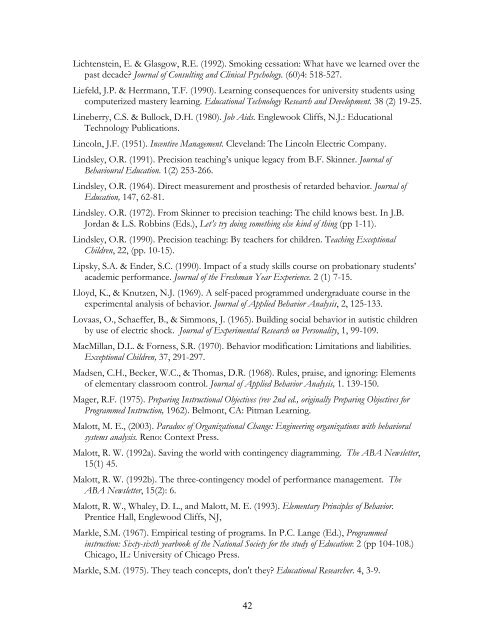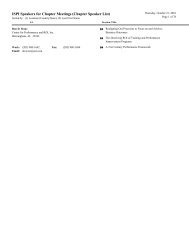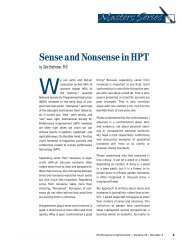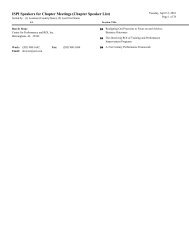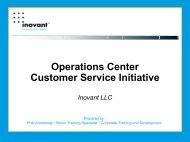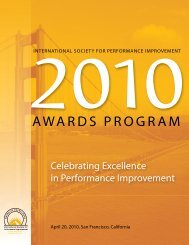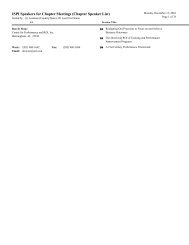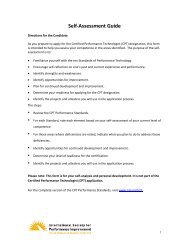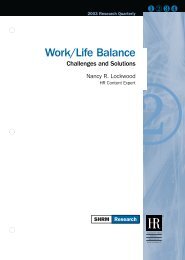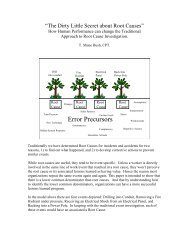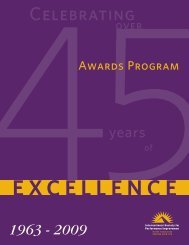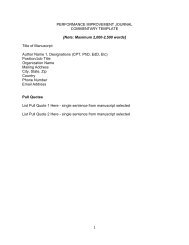Yes We Can! - International Society for Performance Improvement
Yes We Can! - International Society for Performance Improvement
Yes We Can! - International Society for Performance Improvement
Create successful ePaper yourself
Turn your PDF publications into a flip-book with our unique Google optimized e-Paper software.
Lichtenstein, E. & Glasgow, R.E. (1992). Smoking cessation: What have we learned over the<br />
past decade? Journal of Consulting and Clinical Psychology. (60)4: 518-527.<br />
Liefeld, J.P. & Herrmann, T.F. (1990). Learning consequences <strong>for</strong> university students using<br />
computerized mastery learning. Educational Technology Research and Development. 38 (2) 19-25.<br />
Lineberry, C.S. & Bullock, D.H. (1980). Job Aids. Englewook Cliffs, N.J.: Educational<br />
Technology Publications.<br />
Lincoln, J.F. (1951). Incentive Management. Cleveland: The Lincoln Electric Company.<br />
Lindsley, O.R. (1991). Precision teaching’s unique legacy from B.F. Skinner. Journal of<br />
Behavioural Education. 1(2) 253-266.<br />
Lindsley, O.R. (1964). Direct measurement and prosthesis of retarded behavior. Journal of<br />
Education, 147, 62-81.<br />
Lindsley. O.R. (1972). From Skinner to precision teaching: The child knows best. In J.B.<br />
Jordan & L.S. Robbins (Eds.), Let’s try doing something else kind of thing (pp 1-11).<br />
Lindsley, O.R. (1990). Precision teaching: By teachers <strong>for</strong> children. Teaching Exceptional<br />
Children, 22, (pp. 10-15).<br />
Lipsky, S.A. & Ender, S.C. (1990). Impact of a study skills course on probationary students’<br />
academic per<strong>for</strong>mance. Journal of the Freshman Year Experience. 2 (1) 7-15.<br />
Lloyd, K., & Knutzen, N.J. (1969). A self-paced programmed undergraduate course in the<br />
experimental analysis of behavior. Journal of Applied Behavior Analysis, 2, 125-133.<br />
Lovaas, O., Schaeffer, B., & Simmons, J. (1965). Building social behavior in autistic children<br />
by use of electric shock. Journal of Experimental Research on Personality, 1, 99-109.<br />
MacMillan, D.L. & Forness, S.R. (1970). Behavior modification: Limitations and liabilities.<br />
Exceptional Children, 37, 291-297.<br />
Madsen, C.H., Becker, W.C., & Thomas, D.R. (1968). Rules, praise, and ignoring: Elements<br />
of elementary classroom control. Journal of Applied Behavior Analysis, 1. 139-150.<br />
Mager, R.F. (1975). Preparing Instructional Objectives (rev 2nd ed., originally Preparing Objectives <strong>for</strong><br />
Programmed Instruction, 1962). Belmont, CA: Pitman Learning.<br />
Malott, M. E., (2003). Paradox of Organizational Change: Engineering organizations with behavioral<br />
systems analysis. Reno: Context Press.<br />
Malott, R. W. (1992a). Saving the world with contingency diagramming. The ABA Newsletter,<br />
15(1) 45.<br />
Malott, R. W. (1992b). The three-contingency model of per<strong>for</strong>mance management. The<br />
ABA Newsletter, 15(2): 6.<br />
Malott, R. W., Whaley, D. L., and Malott, M. E. (1993). Elementary Principles of Behavior.<br />
Prentice Hall, Englewood Cliffs, NJ,<br />
Markle, S.M. (1967). Empirical testing of programs. In P.C. Lange (Ed.), Programmed<br />
instruction: Sixty-sixth yearbook of the National <strong>Society</strong> <strong>for</strong> the study of Education: 2 (pp 104-108.)<br />
Chicago, IL: University of Chicago Press.<br />
Markle, S.M. (1975). They teach concepts, don't they? Educational Researcher. 4, 3-9.<br />
42


